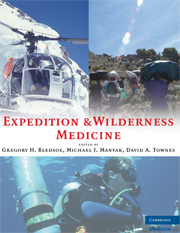APPENDIX - The Expedition Medical Kit
Published online by Cambridge University Press: 05 March 2013
Summary
As discussed in Chapter 3, packaging the medical kit into modules, or functional units, aids the management and control of medical supplies. The items to be chosen and the quantities to be packed vary by the factors discussed in the referenced chapter. The basic modules listed below are divided into four functional groups: Topical Bandaging Module, Nonprescription (Non-Rx) Oral Medication Module, Prescription (Rx) Oral/Topical Medication Module, and a Prescription Injectable Medication Module. The functional utility of the items in the modules is described here. Various chapters in this book describe specific high-risk situations.
BASIC EXPEDITION MEDICAL KIT MODULES
This basic expedition kit consists of four modules: These kits and the use of each component have been described in detail in the referenced books (Forgey, 2002; 2007). The modules are capable of sustaining a group of six persons operating for 2 months in a very remote area, assuming a higher risk than was reported in the Boy Scout Adirondack study (Welch, 1997) or the NOLS data (Leemon and Schimelpfenig, 2003) and assuming the need for providing long-term and definitive care for expedition members. Because loss or consumption of kits can lead to shortages of items, a wilderness traveler must be adept at improvisation. Improvised alternatives to the kit components have been suggested.
As a minimum, the Topical Bandaging Module and Non-Rx Oral Medication Module will generally fulfill the vast majority of emergency treatment requirements. In that all components are nonprescription items, they can be readily obtained by any group requiring a basic expedition medical kit.
- Type
- Chapter
- Information
- Expedition and Wilderness Medicine , pp. 709 - 714Publisher: Cambridge University PressPrint publication year: 2008



